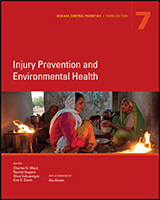The world continues to suffer from an enormous burden of morbidity, disability, and premature mortality from injuries and environmental health conditions. Much of this burden is unnecessary and can be prevented by evidence-based, high-impact interventions that can be implemented in all countries, irrespective of income.
Injuries are leading causes of death, responsible for an estimated 5 million deaths and around 9 percent of global mortality. Most of the deaths are in low- and middle-income countries (LMICs). More than 1.2 million people die too young each year because of road traffic injuries. According to the World Health Organization’s (WHO) Global Status Report 2015, death rates in low-income countries are more than double those in high-income countries. The African region has the highest death rates.
The current situation presents a major challenge to socioeconomic development and has rightly been the focus of attention globally and within all countries. In 2010, a decade for action on road safety was established by the United Nations General Assembly; more recently, in 2015, as part of the Sustainable Development Goals, countries of the world made an ambitious commitment to halving the number of global deaths and injuries due to road traffic crashes by 2020.
There is, therefore, a pressing need for action. This volume of Disease Control Priorities, third edition provides an excellent evidence-based guide to policy makers on the approaches and rational choice of interventions to address this challenge. Many of the interventions included in the volume are among the most cost-effective interventions in public health and can make a substantial impact on reducing the health and socioeconomic burden due to injuries, particularly in LMICs. Yet, current progress is too slow. As highlighted in this volume and documented in the Global Status Report, implementation of the key public health measures is disappointingly low. Countries, particularly LMICs, need to do more. Policy makers should seriously consider the recommendations of this volume when they develop their own essential package of interventions, which is one of the three key pathways to achieve universal health coverage. International organizations and development agencies should increase their support to low-income countries to make this possible.
This volume focuses on another key challenge to public health across the globe. Environmental causes lead to more than 8 million deaths per year; outdoor and indoor air pollution accounts for more than 5 million of these deaths per year. Climate change, which results from unsustainable policies in many sectors, exacerbates air pollution threats and causes additional morbidity and mortality. Unsafe sanitation and lack of safe water and hygiene cause an estimated 1.4 million deaths, almost all in LMICs.
Although the enormous burden and serious health challenges caused by environmental risk factors are evident, surveillance and systematic monitoring of the magnitude of the risks and their health impacts are severely limited in many countries. The data gaps are particularly serious for air quality and air pollution levels. Increasing awareness among high-level government officials and policy makers on the seriousness of environmental risks and the pressing need to take effective multisectoral action should be a key priority for all countries. This volume makes a strong case for advocacy and for strengthening commitment, and it provides clear policy advice on strategic directions to consider.
Despite the fact that there are limited economic analysis studies on some environmental health conditions, there is clear evidence for a range of interventions recommended in the volume that are cost-effective or supported by favorable cost-benefit ratios. Implementing them will have a considerable impact on reducing environmental health risks and preventing a broad range of common communicable and noncommunicable conditions responsible for a major proportion of global disease burden and premature mortality. In addition to their desirable health effects, many of these interventions will also have important non-health outcomes that may be part of the priorities of the non-health sectors involved.
An important challenge to health and development is climate change. Although the importance of climate change challenges is increasingly recognized, and tackling them is becoming a global priority, addressing the health consequences is not receiving adequate attention. Policy makers at the highest levels of government and in different sectors need to be made fully aware of the seriousness of the health dimensions and the effective approaches to mitigate them.
Finally, making a difference in addressing injuries and environmental health risks will require solid commitments from all parts of governments, particularly sectors such as transport, energy, industry, agriculture, housing, and waste management. The health sector will have to demonstrate leadership in evidence-based advocacy, governance, technical support, and surveillance. The need to act is highlighted by a range of goals and targets included in the sustainable development agenda. Countries that initiate effective action now will benefit from improved health and realize considerable health care savings.
Ala Alwan, MD, FRCP, FFPH
Regional Director Emeritus,
WHO Eastern Mediterranean Region

